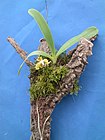Biology:Phalaenopsis hygrochila
| Phalaenopsis hygrochila | |
|---|---|

| |
| Flowering Phalaenopsis hygrochila specimen in cultivation | |

| |
| Flower detail | |
| Scientific classification | |
| Kingdom: | Plantae |
| Clade: | Tracheophytes |
| Clade: | Angiosperms |
| Clade: | Monocots |
| Order: | Asparagales |
| Family: | Orchidaceae |
| Subfamily: | Epidendroideae |
| Genus: | Phalaenopsis |
| Species: | P. hygrochila
|
| Binomial name | |
| Phalaenopsis hygrochila J.M.H.Shaw[1]
| |
| Synonyms[1] | |
| |
Phalaenopsis hygrochila, also known as 湿唇兰 (shi chun lan) in Chinese,[2] is a species of epiphytic orchid native to Assam, China South-Central, China Southeast, East Himalaya, Laos, Myanmar, Thailand, and Vietnam.[1]
Taxonomy
This species has a complex taxonomic history and has been previously assigned to several genera.[1]
Description
The 5–10 cm, sometimes up to 20 cm long stems are 8–15 mm wide and enclosed within persistent leaf sheaths. They bear oblong to obovate-oblong, unequally bilobed, coriaceous leaves, between 17 and 29 cm in length and 3.5-5.5 cm in width. Yellow flowers of 4–5 cm in diameter with purple spotting and a white lip with lavender colouration on the midlobe are produced on 5-8 flowered, axillary and often pendent inflorescences. One plant may produce up to 6 inflorescences at a time. Flowering occurs throughout June and July. The diploid chromosome count is 2n = 38.[2] Each pollinium is completely divided into two unequal halves.[3] The seeds are 238.7 µm long and 81.2 µm wide.[4]
Gallery
Botanical illustration of Phalaenopsis hygrochila as Vanda parishii
Ecology
The plants are found in open forests in elevations of 700–1300 m.[2]
Conservation
This species is protected unter the CITES appendix II regulations of international trade.[5]
Horticulture
It has been utilized as an ornamental plant and cut flowers have been traded commercially, both locally and internationally. Artificial propagation and genetic transformation protocols were established.[6]
References
- ↑ 1.0 1.1 1.2 1.3 "Phalaenopsis hygrochila J.M.H.Shaw | Plants of the World Online | Kew Science". https://powo.science.kew.org/taxon/urn:lsid:ipni.org:names:77145594-1.
- ↑ 2.0 2.1 2.2 Wu, Z.Y., Raven, P.H. & Hong, D.Y. 2009 Flora of China Vol. 25 Orchidaceae Science Press, Beijing, and Missouri Botanical Garden Press St. Louis, MO. 446
- ↑ Li, M. H., Zhang, G. Q., Liu, Z. J., & Lan, S. R. (2014). Revision of Hygrochilus (Orchidaceae: Epidendroideae: Aeridinae) and a molecular phylogenetic analysis. Phytotaxa, 159(4), 256-268.
- ↑ Tongbram, J., Rao, A. N., & Vij, S. P. (2012). Seed morphometric studies in some orchids from Manipur. J. Orch. Soc. Ind, 26(1-2), 25-2.
- ↑ "Phalaenopsis". https://cites.org/eng/taxonomy/term/33584.
- ↑ Pimda, W., & Bunnag, S. (2010). Protocorm wounding enhanced Agrobacteriummediated transformation of Hygrochilus parishii (Veitch & Rchb. f.) Pfitz. Advances in Agriculture & Botanics, 2(3), 205-212.
Wikidata ☰ Q63384963 entry
 |







